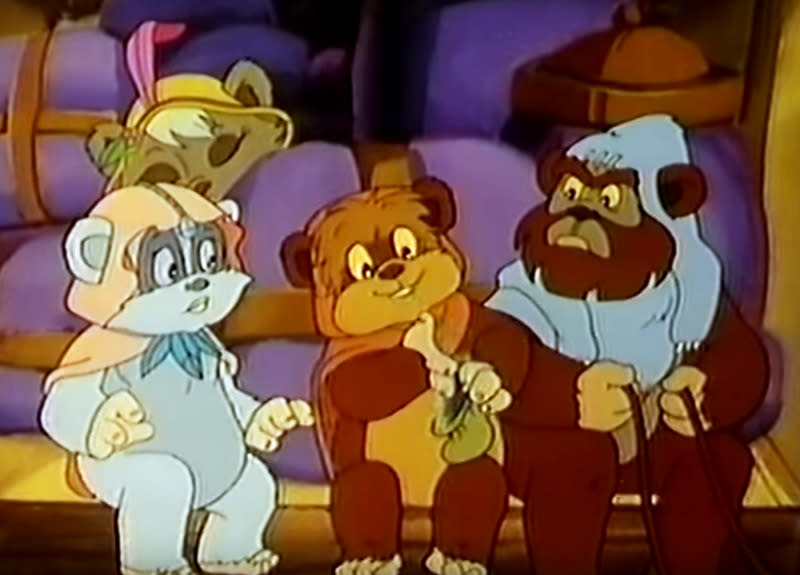'Star Wars': How 'Ewoks' and 'Droids' Arrived on Saturday Morning TV

With the hotly-anticipated Star Wars: The Force Awakens now in theaters, the Force is extra-strong with one of the biggest film franchises around. Of course Star Wars isn’t confined to the big screen; fans can spend time in George Lucas’s galaxy in novels, comic books and Disney XD’s popular animated series Star Wars Rebels. That show is the latest entry in a long history of Star Wars cartoons that dates back to the mid-‘80s, after the release of Return of the Jedi put a button on the original trilogy.
Related: How the Ewoks Came to TV 31 Years Ago
Around the same time that Lucas was exploring the franchise’s television opportunities with two made-for-TV movies starring Jedi’s breakout forest critters, the Ewoks, he sold ABC on a pair of cartoons for their Saturday morning line-up: Ewoks and Droids. The latter followed everyone’s favorite robot twosome, C-3PO (voiced, as always, by Anthony Daniels) and R2-D2, on their various adventures before the events of A New Hope. Ewoks, meanwhile, unfolded on Endor in the years before Luke and Leia showed up on their mission to blow up the second Death Star.
Back in the mid-‘80s, being able to wake up on Saturday mornings and watch new animated adventures in the Star Wars universe was a novelty for fans. These days, though, neither show is part of official Star Wars continuity, and, in fact, are completely out of print. But they still represent a fascinating period in the franchise’s history, when Star Wars was exploring opportunities beyond the big screen.

Paul Dini, one of the creative forces behind some of TV’s all-time greatest animated series — including Tiny Toon Adventures, Batman: The Animated Series and Batman Beyond — as well as an established comic book author (his latest graphic novel, Dark Knight: A True Batman Story, will be released next year), was a key figure in the Ewoks writers’ room. By the time the series drew to a close, he had written 14 out of the 35 produced episodes, and contributed a teleplay to Droids as well. Yahoo TV spoke with Dini about launching the earliest Star Wars cartoon series, which characters that could (and couldn’t) appear on Ewoks and Droids, and the Ewok cameo he wanted to include in the Clone Wars animated series.
Ewoks is among your earliest writing credits on an animated series. Was it a dream of yours to write for Star Wars?
Oh, of course. I loved Star Wars; I saw the first movie when I was 18, and was a huge geek from that moment on. It was a great time to be at Lucasfilm in the mid-‘80s; besides Star Wars, there was Indiana Jones and other tremendous movies being made. And [Pixar founder] John Lasseter was in the next building over animating blobs and squiggles and stuff. I would go over there and watch what he was doing, and knew it would be huge someday. They were very generous with the artwork and props; you could check out early Ralph McQuarrie Star Wars concept paintings [from the archives] and display them in your office. I also had the Mummy case from Raiders of the Lost Ark outside my office, and the fertility idol as a paperweight on my desk. And being entrusted with the next phase of Star Wars was terrific. It was a challenge to go in and say, “Let’s make it the best show we can and give it its own energy and mythology.”
What was the guiding idea behind Star Wars’ next phase at that point?
George was coming off Return of the Jedi and had basically said he was done with Star Wars because he wanted to make different types of films. But they wanted to keep Star Wars alive in different forms through licensing, publishing and animation. Back then, Saturday morning television was really the only game in town for animation, so he [struck a deal] with ABC for two shows: Droids and Ewoks. The series would be set in the Star Wars universe, but didn’t really have to tie into the main story. So there’d be no Luke, no Leia and no Empire to speak of. I think George looked at Droids as being the series that would interest older boys, and Ewoks was going to appeal to younger kids. He didn’t want to do basic Saturday morning stories, but at that point, nobody had really come along that could challenge what was being done in animated storytelling. It would be about another ten years before that happened.

 Yahoo Autos
Yahoo Autos 
